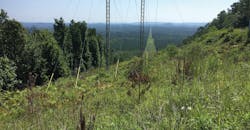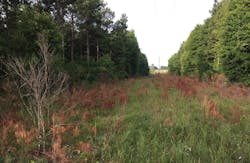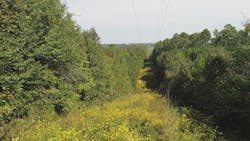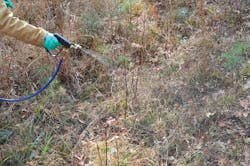Capture Dormant-Season Opportunities
Cool late-season temperatures trigger many plant species to shed their foliage and begin an annual period of hibernation until conditions more suitable for growth return next spring. This seasonal change also can signal a sometimes-abrupt end to another season for many vegetation managers and spray crews — foliar spraying season — even when rights-of-way (ROW) maintenance still needs to be done.
When spray treatment cycles are confined only to the growing season, it creates pressure to complete planned work in a somewhat confined window of time. This window narrows even more if spring arrives late or fall arrives early, which is not uncommon, especially in more northern geographies. Then, layer on unforeseen and, in some cases, uncontrollable inputs such as inclement weather, labor shortages or budget fluctuations, and even the best-laid plans easily can be thrown off track. The typical result is vegetation managers face playing a game of catch-up the following season, only then, the same work almost certainly will be more difficult and costlier to perform.
As with many utilities, this result was a common occurrence for Alabama Power Co. — until it found an alternative in dormant-stem treatments. These treatments are an effective and economical solution to address incompatible brush when treatment is postponed during foliar season. They also are an effective means to reduce foliar-season spraying demands, particularly useful in sensitive areas. Applications can be made later in the fall, throughout the winter months and even into spring, when many crews have put away their spray equipment until the next growing season, enabling utilities to more efficiently use their resources.
From Skeptics to Believers
This sounds almost too good to be true, so one might speculate: Is there a catch? Many assume the catch comes in the form of lower effectiveness when compared to foliar spraying. This skepticism was shared by Alabama Power. However, it was offset by optimism that if dormant-stem treatments could match the effectiveness of foliar spraying, in turn, the utility could deliver significant improvements to an already successful vegetation management program.
Alabama Power manages its ROW using an integrated vegetation management (IVM) approach. Part of that approach hinges on the belief a good herbicide program is the most effective way to manage incompatible woody vegetation efficiently. For years, this belief led to incorporating a healthy dose of foliar-season spraying. While the strategy proved successful, there was an opportunity for improvement in the form of an alternative herbicide treatment.
In 2011, as a first step, Alabama Power began a series of trial-and-error experiments using dormant-stem treatments, with input provided by Corteva Agriscience. The main goal was to determine if the dormant-stem treatments could exhibit the same level of control as its foliar applications. Utility personnel felt that if the results showed the same level of control could be achieved, there was potential to address three ongoing challenges with the ROW maintenance program.
First, Alabama Power wanted a better way to manage woody species while at the same time enhancing native grasses and forbs. Second, it sought the ability to implement herbicide applications using lover extended application windows for increased operational flexibility. Finally, the utility wanted to improve how it made herbicide applications in sensitive areas to reduce customer complaints.
When the data from the experiments was gathered and reviewed, the results provided the impetus to begin implementing dormant-stem treatments. The control results also were backed by separate field data gathered by Corteva Agriscience, which consistently shows utilities’ correct use of dormant-stem treatments results in anywhere from 85% or better control on hardwoods — such as maple and oak — and conifers — such as pine — which, along with mimosa, privet and tree-of-heaven, are some of the more predominant species Alabama Power targets on its ROW.
Fast-forward to today and dormant-stem treatments are considered a key component of Alabama Power’s ROW maintenance program. Since implementation, these treatments have been applied on an increasing number of acres, to the point the utility estimates dormant-stem treatments were used on more than 52,000 acres from 2016 to 2018. Because of its adoption of dormant-stem treatments, Alabama Power has achieved three key improvements in ROW management.
Uncompromised Control
Many vegetation management conversations begin and end with control. While Alabama Power found, in its initial trials and subsequent years of field work, dormant-stem control can serve to enhance the utility’s ability to manage incompatible woody species, it also has seen the positive impact such treatments can have on native grasses and forbs within ROW. Besides simply creating more aesthetically pleasing ROW, Alabama Power has seen an increase in beneficial grasses, desirable forbs and shrubs that provide habitat for critical pollinator species and other area wildlife.
A more practical benefit for vegetation managers is that releasing desirable vegetation to thrive provides a biological barrier of sorts against further woody plant establishment. This has saved Alabama Power valuable time and resources on future treatment cycles.
This was possible in large part by Alabama Power’s decision also to incorporate selective herbicide technology into its dormant-stem treatments. Selective herbicides enable a utility to target incompatible weeds and brush while exhibiting little-to-no activity on desirable vegetation-like grasses. Currently, Alabama Power uses a low-volume application tank mix that consists of Garlon 4 Ultra herbicide at a rate of 6%, Milestone herbicide at 0.66%, imazapyr at 0.5% and a methylated seed oil at 2%. While imazapyr is considered selective, it will control certain grasses. However, this is offset by applying it when grasses go dormant in the winter, enabling them to recover relatively quickly in the spring.
Timing Provides Flexibility
Dormant-stem treatments are most effective beginning at fall leaf drop and continuing until early bud break. Alabama Power has found October through January to be the optimal timing. This flexible late-season timing provides the opportunity to implement herbicide applications over an extended treatment window. This enables the utility to reallocate work crews from late spring and summer to fall and winter, when most crews are shutting down. The benefit comes from the ability to pick up where foliar crews leave off. Otherwise, when crews halt work before completing treatment cycles, any skipped brush can grow an estimated 20% to 40% from one year to the next. This means more time and material are needed to treat what has grown, because the new growth has transformed into a harder-to-control problem.
In fact, recently published field studies from Corteva found delaying routine vegetation management by only one growing season can double maintenance costs. Those same studies also showed it typically requires 20% more time and material to make growing-season herbicide applications vs. treatments made in the dormant season.
Low-Visibility Solution
Most landowners and members of the public are unable to tell the difference between a dead tree and a dormant tree, as neither shows any obvious signs of life. Many times, success achieved by making an herbicide application that controls a problem tree during its hibernation period often is simply chalked up to it not being able to survive the winter. This can significantly reduce public visibility in comparison with growing-season applications, when a much more noticeable brownout occurs post application. Less public visibility of post-treatment brownouts can lead to reduced landowner complaints.
A good example of this is Alabama Power’s agreement with the Alabama Department of Transportation (DOT) to use dormant-stem treatments on distribution lines near roads. The treatments improved aesthetics because of the reduced brownout in these highly visible areas and resulted in fewer complaints for both the Alabama DOT and Alabama Power.
Right Approach for Success
Those thinking of adding dormant-stem treatments to an IVM program should consider a few things first. For starters, it is recommended applicators be trained in specific application techniques. This training helps to ensure optimal control, because proper application achieves the best results. In general, dormant-stem applications are similar in technique to foliar applications; however, there is no foliage to spray (except with evergreen species such as conifers, which are treated the same as dormant deciduous trees). Applicators should start at the crown of the stem and work their way down, covering each terminal bud for best results.
Dormant-stem treatments can benefit even successful utility ROW programs, as with Alabama Power’s program, offering improvements such as extended application windows, more operational flexibility and fewer customer complaints. As summer transitions to fall, marking the end of foliar spraying, vegetation management teams might wish they had been able to do more during the season. Alabama Power found out it could.
Editor’s Note: For more information on the trial and field results mentioned in this article, contact the authors.
About the Author
Corey Sweeney
Corey Sweeney is the power delivery contract services manager for Alabama Power Co. and current chairman of the vegetation management committee for Southern Co. He is responsible for providing leadership and direction of the vegetation management program for the entire T&D system, which totals more than 70,000 miles of ROW corridors. Sweeney received his BSEE degree from the University of Alabama and his MBA degree from the University of Alabama at Birmingham. He is an ISA certified arborist and holds a commercial applicators permit.
Logan Martin
Logan Martin is a territory manager for the land management business of Corteva Agriscience. In his role, he works with utilities to develop vegetation management programs throughout Alabama, Mississippi and the Florida panhandle. Martin received his bachelor’s degree in agronomy from Missouri State University and his master’s degree in agronomic weed science from the University of Florida.



